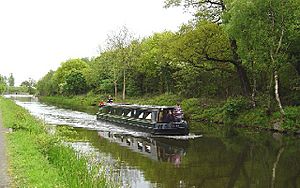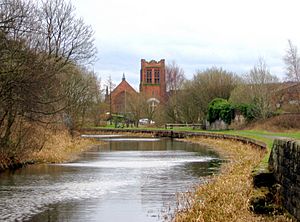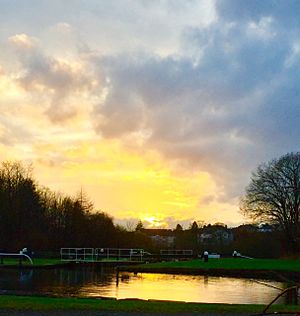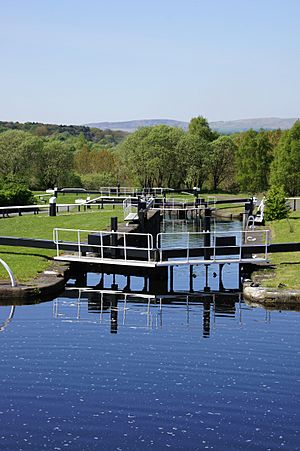Forth and Clyde Canal facts for kids
The Forth and Clyde Canal is a famous canal in central Scotland. It opened in 1790 and was a very important waterway. The canal allowed ships to travel between the Firth of Forth on the east coast and the Firth of Clyde on the west coast. This meant boats could go from Edinburgh to Glasgow without sailing all the way around the north of Scotland!
The canal is about 35 miles (56 km) (56 km) long. It stretches from the River Carron near Grangemouth to the River Clyde at Bowling. It also had a key harbour area called Port Dundas in Glasgow.
The Forth and Clyde Canal was very successful for many years. However, ships started to get much bigger and could no longer fit through the canal. Later, the rise of railways also made the canal less popular. By the 1930s, it was hardly used. The canal officially closed in the early 1960s. This was because the cost of keeping the bridges over the canal in good repair was too high.
Part of the canal's path in Glasgow was even used to build the M8 motorway. But in recent times, people have worked hard to bring the canal back to life for fun activities like boating and walking.
Contents
Where is the Forth and Clyde Canal?
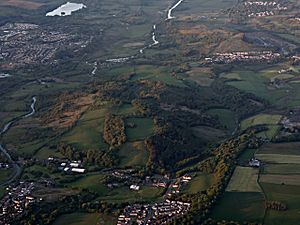
The eastern end of the canal connects to the River Forth through the River Carron near Grangemouth. The canal generally follows the path of the ancient Roman Antonine Wall. Building it was the biggest construction project in Scotland since Roman times!
The highest part of the canal is near Kilsyth. Water for the canal comes from a special reservoir called Townhead, near Banton. This water then flows into the canal.
The canal continues past towns like Twechar, Kirkintilloch, and Bishopbriggs. It reaches the Maryhill area, north of Glasgow. A special branch of the canal was built to Port Dundas. This was to make sure that merchants in Glasgow would support the canal. This branch even passes by student homes for the University of Glasgow. The western end of the canal joins the River Clyde at Bowling.
In 1840, a short canal, the Forth and Cart Canal, was built. It connected the Forth and Clyde Canal near Whitecrook to the River Clyde.
How the Canal Started
The idea for the Forth and Clyde Canal began a long time ago. The first official law to build it was passed on March 8, 1768. The plan was to create a navigable canal from the Firth of Forth near the River Carron to the Firth of Clyde near Dalmuir. There was also a plan for a side branch to Glasgow.
The people who invested in the canal were called "The Company of Proprietors of the Forth and Clyde Navigation." They aimed to raise £150,000 for the project.
At first, it was hard to get enough money. But thanks to a big investment from Sir Lawrence Dundas, 1st Baronet, work began quickly. The engineer, Mr. Smeaton, led the project. In less than three years, half of the canal was finished! However, work stopped in 1775 because they ran out of money. It stayed unfinished for several years.
Finally, a clever solution was found. The Scottish government lent the company £50,000. This allowed work to restart under a new engineer, Mr. Robert Whitworth. The entire canal was finally completed on July 28, 1790.
Life on the Canal in the Past
In 1831, a writer named Priestley described the canal. He said it connected to the Edinburgh and Glasgow Union Canal near Falkirk. It also linked up with railways and other canals near Glasgow.
The canal started in Grangemouth Harbour. It ran west, passing north of Falkirk and south of Kilsyth. It crossed the River Kelvin and the Luggie Water using large stone bridges called aqueducts. The branch to Port Dundas brought the canal close to Glasgow.
The canal was thirty-five miles (56 km) long. It had a rise of 155 feet (47 m) from the Forth, using 20 locks. The highest part of the canal was sixteen miles (26 km) long. Then, it dropped 156 feet (48 m) to the Clyde, using 19 more locks.
Even though the canal was first built for boats that drew 7 feet (2.1 m) of water, later improvements allowed larger ships (drawing 10 feet (3.0 m)) to use it. The locks were 23 m long and 6 m wide. Along its path, there were 33 drawbridges and many aqueducts. The aqueduct over the Kelvin River was huge, 429 feet (131 m) long and 65 feet (20 m) high!
Boats and Passengers
The Forth and Clyde Canal was important for testing early steamboats. Between 1789 and 1803, William Symington tried out his steamboats here. This led to the Charlotte Dundas, which was called the "first practical steamboat." It was built in Grangemouth.
Passenger boats started running on the canal in 1783. By 1809, fast boats were introduced. They could travel from Edinburgh to Falkirk in just 3 hours and 30 minutes! These boats offered comforts like food, drinks, and newspapers. By 1812, they carried 44,000 passengers, showing how popular they were.
A steamboat service, run by Thomas Grahame's boat Cupid, began in 1828.
Building the Canal
The canal was designed by a famous engineer named John Smeaton. Construction began in 1768. There were some delays because of money problems, but it was finally finished in 1790.
A well-known geologist called James Hutton was very involved in the canal project. He used his knowledge of rocks and land to help with the construction. He also visited the sites and was part of the management team.
Later, the Union Canal was built. It connected the eastern end of the Forth and Clyde Canal to Edinburgh.
Who Owned the Canal?
Over the years, the canal's ownership changed several times. In 1842, a law was passed that allowed the Caledonian Railway company to take over the Forth and Clyde Canal. This change happened in 1867. The Canal company itself had even built a railway line to Grangemouth Dock, which it owned.
In 1948, the canal became owned by the government, along with the railway companies. Control then went to the British Transport Commission. In 1962, control passed to the British Waterways Board. Today, Scottish Canals looks after it.
Decline and Rebirth
In 1963, the canal was closed. This was partly because a new motorway was planned to cross it. Parts of the canal, especially the Canal locks near Falkirk, had already been filled in during the 1930s.
But for the millennium celebrations in 2000, money from the National Lottery was used to bring both the Forth and Clyde Canal and the Union Canal back to life! A special boat lift, called the Falkirk Wheel, was built to connect the two canals. This amazing machine allows boats to travel between the Clyde or Glasgow and Edinburgh once again. A new connection was also made to the River Carron and the River Forth. The Falkirk Wheel opened on May 27, 2002, and is now a popular tourist attraction.
The Port Dundas branch of the canal has also been reconnected. New sections of canal and two locks were built. This project cost £5.6 million. The first lock opened in September 2006.
Forth and Clyde Canal Society
The Forth and Clyde Canal Society is a group of people who love the canal. It was started in 1980. Their goal was to "campaign for the Forth and Clyde's preservation, restoration and development."
Today, the Society's main aim is to "promote the canal and to ensure its success." They collected over 30,000 signatures on a petition to reopen the canal. This helped lead to the Millennium Link project, which started in 1999 and brought the canal back to life.
The Society now has four boats. They use these boats for trips, charters, and cruises for their members along the canal.
Canal Locks
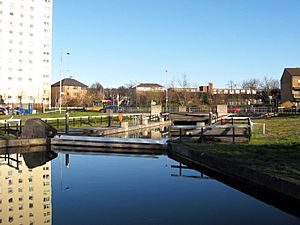
There are 39 locks on the Forth and Clyde Canal. Locks are like water elevators that help boats move up or down between different water levels.
Some of the locks include:
- The New River Carron Sea Lock near The Kelpies.
- Several locks around Camelon and Falkirk.
- The Falkirk Wheel acts like a giant lock, connecting the Forth and Clyde Canal to the Union Canal.
- Several locks in Maryhill, Glasgow, including the Maryhill Top Lock.
- The unique Dalmuir Drop Lock, which helps boats pass under a fixed bridge.
- The Bowling Lock, which connects the canal to the River Clyde.
The locks are generally 23 m long and 6 m wide. This allows boats of a certain size to pass through. At the western end, the Bowling basin is wider for larger ships.
See also
 In Spanish: Canal de Forth y Clyde para niños
In Spanish: Canal de Forth y Clyde para niños


